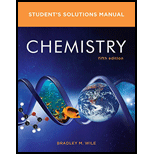
Concept explainers
(a)
Interpretation: The compound with greatest percentage of carbon by mass is to be determined. If any two of the given compounds have same empirical formula is to be stated.
Concept introduction: Empirical formula signifies the simplest or most reduced ratio of elements in a compound. Molecular formula is obtained by multiplying empirical formula with a multiple.
To determine: The percentage of carbon by mass in the given compound and its empirical formula.
(a)
Answer to Problem 3.81QP
Solution
The percentage of carbon by mass in the given compound is
Explanation of Solution
Explanation
The given compound is naphthalene (
The molar mass of naphthalene (
There is
Molar mass of
Molar mass of
Substitute the values of number of carbon and hydrogen atoms and their respective masses in the above equation.
The mass percentage of carbon (
Mass of
Substitute the value of mass of
Therefore, the mass percentage of carbon (
The molecular formula of naphthalene is
The ratio of
Thus the empirical formula of naphthalene is
(b)
To determine: The percentage of carbon by mass in the given compound and its empirical formula.
(b)
Answer to Problem 3.81QP
Solution
The percentage of carbon by mass in the given compound is
Explanation of Solution
Explanation
The given compound is chrysene (
The molar mass of chrysene (
There is
Molar mass of
Molar mass of
Substitute the values of number of carbon and hydrogen atoms and their respective masses in the above equation.
The mass percentage of carbon (
Mass of
Substitute the value of mass of
Therefore, the mass percentage of carbon (
The molecular formula of chrysene is
The ratio of
Thus the empirical formula of chrysene is
(c)
To determine: The percentage of carbon by mass in the given compound and its empirical formula.
(c)
Answer to Problem 3.81QP
Solution
The percentage of carbon by mass in the given compound is
Explanation of Solution
Explanation
The given compound is pentacene (
The molar mass of pentacene (
There is
Molar mass of
Molar mass of
Substitute the values of number of carbon and hydrogen atoms and their respective masses in the above equation.
The mass percentage of carbon (
Mass of
Substitute the value of mass of
Therefore, the mass percentage of carbon (
The molecular formula of pentacene is
The ratio of
Thus the empirical formula of pentacene is
(d)
To determine: The percentage of carbon by mass in the given compound and its empirical formula.
(d)
Answer to Problem 3.81QP
Solution
The percentage of carbon by mass in the given compound is
Explanation of Solution
Explanation
The given compound is pyrene (
The molar mass of pyrene (
There is
Molar mass of
Molar mass of
Substitute the values of number of carbon and hydrogen atoms and their respective masses in the above equation.
The mass percentage of carbon (
Mass of
Substitute the value of mass of
Therefore, the mass percentage of carbon (
The molecular formula of pyrene is
The ratio of
Thus the empirical formula of pyrene is
Therefore, the compound with greatest percentage of carbon by mass is pyrene (
Conclusion
The compound with greatest percentage of carbon by mass is pyrene (
Want to see more full solutions like this?
Chapter 3 Solutions
Student Solutions Manual Chemistry
 ChemistryChemistryISBN:9781305957404Author:Steven S. Zumdahl, Susan A. Zumdahl, Donald J. DeCostePublisher:Cengage Learning
ChemistryChemistryISBN:9781305957404Author:Steven S. Zumdahl, Susan A. Zumdahl, Donald J. DeCostePublisher:Cengage Learning ChemistryChemistryISBN:9781259911156Author:Raymond Chang Dr., Jason Overby ProfessorPublisher:McGraw-Hill Education
ChemistryChemistryISBN:9781259911156Author:Raymond Chang Dr., Jason Overby ProfessorPublisher:McGraw-Hill Education Principles of Instrumental AnalysisChemistryISBN:9781305577213Author:Douglas A. Skoog, F. James Holler, Stanley R. CrouchPublisher:Cengage Learning
Principles of Instrumental AnalysisChemistryISBN:9781305577213Author:Douglas A. Skoog, F. James Holler, Stanley R. CrouchPublisher:Cengage Learning Organic ChemistryChemistryISBN:9780078021558Author:Janice Gorzynski Smith Dr.Publisher:McGraw-Hill Education
Organic ChemistryChemistryISBN:9780078021558Author:Janice Gorzynski Smith Dr.Publisher:McGraw-Hill Education Chemistry: Principles and ReactionsChemistryISBN:9781305079373Author:William L. Masterton, Cecile N. HurleyPublisher:Cengage Learning
Chemistry: Principles and ReactionsChemistryISBN:9781305079373Author:William L. Masterton, Cecile N. HurleyPublisher:Cengage Learning Elementary Principles of Chemical Processes, Bind...ChemistryISBN:9781118431221Author:Richard M. Felder, Ronald W. Rousseau, Lisa G. BullardPublisher:WILEY
Elementary Principles of Chemical Processes, Bind...ChemistryISBN:9781118431221Author:Richard M. Felder, Ronald W. Rousseau, Lisa G. BullardPublisher:WILEY





